

Reframing the "Whole Self" Challenge. Fears are nothing more than a state of mind -Napoleon. Podcast: Story Power Lab - Confidently step into change with Phil Buckley. LinkedIn by Sean McPheat. Why we're so terrified of the unknown. How to Help People Let Go of the Past. Afraid of afraid. Contagious commerce. Early adopters change the world.

While one person choosing not to eat meat will have a small impact on our climate, it will have a much bigger impact on the restaurants, groceries and food suppliers who notice what you’re doing. They’ll change what they offer, and that will lead to a multiplier effect of other people changing their habits. Buying an electric car or installing solar before they’re the obvious economic choice has the same impact. Because once marketers and investors discover that there’s a significant group that likes to go first, they’re far more likely to invest the time and energy to improve what’s already there. The same goes for philanthropy. It also happens in the other direction. Very few people have the leverage to change the world. Do you remember having a change inflicted on you? On-demand webinar: The Individual and the System: A Dual Lens on Change Management, With Ochuko Igbeyi.
Podcast: Play in new window | Download Subscribe: Apple Podcasts | In this episode of the Change Management Review™ Podcast, Brian Gorman interviews Ogheneochuko (Ochuko) Igbeyi – an experienced change leadership advocate in financial services with over 20 years multi-disciplinary and multi-cultural experience in Nigeria, West Africa, and Canada.
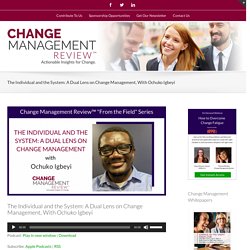
He is PMP and Change Management certified with practical experience in product management, process improvement and relationship management. Ochuko has a passion for personal development, continuous improvement, building strong relationships by inspiring with humour and empathy. He is a husband, a father, a faithful friend, and a lifelong learner. Stop Waiting For Your Change to Happen. Several years ago, while travelling in Italy, we visited a winery outside the city of Cortona.

The family has been making wine for generations. It was one of several we saw during our time in Italy. Although most of the wineries had adopted modern wine-making practices, one thing was common. Four key aspects to helping employees understand change. Flux: 8 Superpowers for Thriving in Constant Change (24 August 2021) by April Rinne. LinkedIn by Sean McPheat. The 25 Drives Grid. What motivates your customers to use your product?
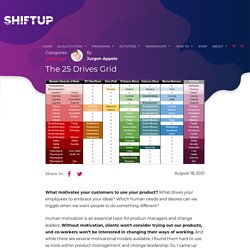
What drives your employees to embrace your ideas? Which human needs and desires can we trigger when we want people to do something different? Human motivation is an essential topic for product managers and change leaders. Without motivation, clients won’t consider trying out our products, and co-workers won’t be interested in changing their ways of working. And while there are several motivational models available, I found them hard to use as tools within product management and change leadership. In this article, I explain how I came up with the 25 Drives Grid. Theories versus Tools Let’s begin with the idea that there are two kinds of models. We can consider colors as an example. CHANGE REACTIONS: Anticipate, Embrace & Opportunitise. Change is real and inevitable.
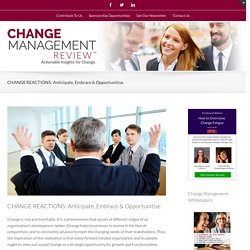
It is a phenomenon that occurs at different stages of an organization’s development ladder. Change helps businesses to evolve in the face of competition, and to constantly advance to meet the changing needs of their stakeholders. CHANGE REACTIONS: Anticipate, Embrace & Opportunitise. 7 Common Reactions to Change and How to Respond to Them. The 7 Emotional Phases Employees Go Through During Change. When people within an organization are required to change, it is common for them to emotionally identify with the current state.
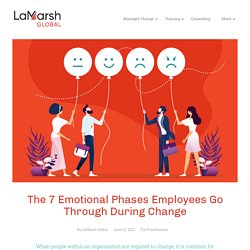
The idea of change can trigger an emotional response. Even before a change is initiated, employees and leaders may feel personal loss, concerns about what will be required of them and apprehensions over their ability to meet any new expectations. Not the same river. Not the same man. It is not possible, said the pre-Socratic Greek philosopher Heraclitus, to step into the same river twice.

As the argument goes, the river is made up of constantly flowing waters, for one thing; for another, people themselves are always changing – life experiences accumulating like sediment on a stream bed. Heraclitus was alluding to the idea of flux: that it doesn’t make sense to think in terms of static states of being, but, rather, in terms of processes unfolding over time. In the contemplative film Not the Same River. Not the Same Man by the German-English filmmaker Michelle Brand, a fisherman takes his boat out to a river, while a bird circles above, and a leaf falls, tracing ripples on the water’s surface. In just a few hand-painted lines of bold blue, black and red acrylic, Brand captures the river’s flow and the fleeting thoughts of the fisherman as they animate his face.
Human reactions to change (2016) Why good mental health is crucial for transformation. Five years ago, Deepak Shukla became so depressed that he called the Samaritans for his own protection.

Some 250 hours of therapy later, the founder of marketing agency Pearl Lemon is acutely aware that many people around him are in a fragile state of mental health, not least because it’s having a detrimental effect on his organisation. “The business is far more inconsistent than it was. We’re performing, but not up to the standard I want us to be at,” he admits. “People are struggling a lot more, which is difficult to know for someone who’s been through it himself.” Shukla’s observation will undoubtedly resonate with many business leaders. In December 2020, 65% of respondents to a YouGov survey reported that their mental health had worsened over the year. The link between good mental health and business transformation is undeniable if you’re hoping for change “When people aren’t well, it feels like constant anxiety and nihilism,” he says. If people don't change, there is no change. Fostering Autonomous Motivation for Change.
What Does Fear Have to Do with Change? Everything. “I learned that courage was not the absence of fear, but the triumph over it.” - Nelson Mandela We all experience fear daily, both in our personal lives and in the workplace.
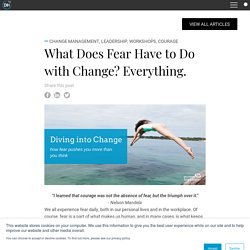
Of course, fear is a part of what makes us human, and in many cases, is what keeps us physically safe. But fear also can stifle the most important drivers of personal growth and workplace innovation. In many cases, our workplace fears are anxieties rooted deep in our reptilian brain: fear of making a mistake, of looking incompetent, of losing professional standing, of feeling embarrassed. What we lose in the process is irreplaceable.
For as long as I can remember, I have been fascinated about what REALLY makes people happy, and several years ago I set out on a personal mission to find out. For me, this is a calling. My passion is fueled by my own personal fears and traumas. After college, I was headed overseas to teach for a year. A flexible routine can help you change for good. The first time I visited Google’s sprawling corporate headquarters was to attend a retreat for its senior human resources directors in 2012.
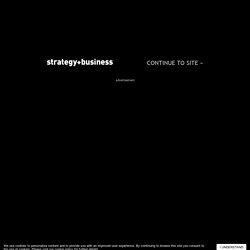
The company was eager to help its employees form better habits around wellness and, in particular, to encourage more employees to use its on-site gyms. Research shows that healthier employees are happier and more productive. Not long after my visit, I called my friends at the tech behemoth and pitched a low-cost strategy that I and my longtime collaborator, Harvard Business School professor John Beshears, were convinced could help.
Podcast: Engaging Those Who Are Changing with Barbara Trautlein. Phil is joined by strategic effectiveness experts John Bradley and Carrie Bradley to discuss how to convey insights through data. Shared understanding is essential during change. People must align on the why, what, when, where, and how of the initiative. Everything must make sense, or doubt, resistance, and risk seep in. How to Change: The Science of Getting from Where You Are to Where You Want to Be (4 May 2021) by Katy Milkman and Angela Duckworth. Positive Affirmation and the Japanese Philosophy of Kintsugi Can Help with Your Change Project. The ancient Japanese art form and philosophy known as Kintsugi may help provide insight on how to deal with rapid and accelerating change.
Roughly translated, Kintsugi means “Golden Seams” or “Golden Repair.” It is the art of broken pieces. It is built on the idea that by embracing flaws and imperfections we can create an even stronger, more beautiful piece of art. The Power of Listening in Helping People Change. Feedback is one of the most common ways we help others learn and develop. But it can backfire when people become defensive. Researchers explored whether a more subtle intervention — asking questions and listening — could be more effective....
Giving performance feedback is one of the most common ways managers help their subordinates learn and improve. To Manage Uncertainty and Loss, Emphasize the Benefits of Change. Over the past year, teams have had to cope with unprecedented levels of loss and uncertainty; some industries have changed more this year than in the last 20. As a leader, you recognize that your organization will need to continue to evolve if you’re going to survive—but how can you bring along a team that just wants some semblance of stability and normalcy? Prospect theory, as defined by psychologists Daniel Kahneman and Amos Tversky, states that people will avoid participating in change for as long as possible—not because they are afraid of what the future holds, but because they don’t want to lose all that they have worked to achieve.
The possibility of loss generates this strong sense of resistance because it’s very difficult for our brains to process the uncertainty of a future gain. LinkedIn by Erika Warfield. How to motivate yourself to change. There are four key stages involved when practitioners use motivational interviewing: engagement, focusing, evocation and planning. Engagement, which we won’t cover further in this Guide, refers to the need for practitioners to build a positive relationship or therapeutic alliance with their client or patient. We’ll start with the next stage, focusing, which helps the practitioner and client identify what issue or concern in the client’s life will be addressed first. How the group changes what we think... Define Changes at the Individual Level. Video: How to Manage Your Innovation Funnel. How to change mindset - the Jahnun lesson.
As a coach helping organizations become agile, I’m asked how to change the mindset of the people, how to help them see things in a different way, notice new possibilities. Will it be a good video? A game? A powerful lecture? While these may be good for some initial motivation, we learn about the real change from the kitchen. Jahnun is “a Yemenite Jewish pastry, originating from the Adeni Jews, and traditionally served on Shabbat morning” (wikipedia) and let me add that it goes very well with an egg and tomatoes. I learned to prepare Jahnun from my friend Vered. Sequence matters in ADKAR.
Symptoms of Missing ADKAR Building Blocks. Some things stay the same. Report: Mindset Shifts: What Are They? Why Do They Matter? How Do They Happen? The opportunity of the laggards. (There are some fractions here, please persist. It’s worth it.) Imagine that you have a daily drive. Half of it by distance is on dirt roads where your car can drive 10 miles an hour. How to Address Changing Attitude in Organizational Behavior. Employee Attitude Towards Organizational Change: A Guide. How to Handle Attitude Change in an Organization in 5 Steps. The Power of Listening in Helping People Change. The mass personalization of change: Large-scale impact, one individual at a time.
In this episode of the McKinsey Podcast, Simon London speaks with McKinsey senior partner Bill Schaninger and McKinsey partner Alexander DiLeonardo about organizational change. An edited transcript of their conversation follows. NOW is the Time to Reinvent Ourselves. Be the Hero of Your Change. LinkedIn by Katrijn Van Oudheusden. Making oneself uncomfortable and the 4 states of flow. Tool: Personal Change Management Workbook. Are Your People Change Enabled? Accept Discomfort. I have a secret to share with you, one that’s taken me a really long time to take on board: personal growth and development isn’t always fun.
When one size doesn’t fit all: How to make change personal. October 26, 2020Successfully transforming an organization continues to be one of the greatest challenges facing leaders, as it requires changing the behaviors and underlying mindsets of a critical mass of people. Behavioral-science research shows that there are four levers to driving change: role modeling, fostering understanding and conviction, reinforcing with formal mechanisms, and building confidence and skills. Together, these are known as the influence model. A change-management plan that uses all four levers increases the likelihood of success threefold. However, we live in an increasingly personalized world where people expect information to be curated just for them.
Cookies for change (or, Easy ways to help people move towards a goal) Sometimes cookies are the solution. At a recent family get together Theresa was talking about her study habits as she prepared for medical exams. “It’s hard to say focused. Sometimes I put a cookie in the textbook every 10 pages. No cookie until I finish studying each part!” Does a performance dip always occur during organisational change?
From drug addict to behavioural neuroscientist - a story about change w/Judy Grisel. The Power to Change: How to Harness Change to Make it Work for You (3 October 2020) by Campbell Macpherson. Driving organizational and behavior changes during a pandemic. On the secret of handling change. After awareness comes desire... Introducing a New Model for Personal Change: The SCARED-SO WHAT™ Change Model. Personalizing change programs in the smartphone era. The mass personalization of change: Large-scale impact, one individual at a time.
If you feel like you're doing your best and still experiencing the madness of painful change. Cognitive Bias infographic. Helping People Change - Book Summary. There's no avoiding it. Change Hurts. How to Keep Your Distance and Your Friends. How will the coronavirus change our lives? Aiming ADKAR at Today's Change Challenges (On demand webinar) How We Change: (And Ten Reasons Why We Don't) (2020) by Ross Ellenhorn. Quick-Start Guides: Actionable Insights for Today's Change Challenges. Aiming ADKAR at Today's Change Challenges (On demand webinar) Define Changes at the Individual Level. ADKAR helps us unlock individual change. How to cope with unexpected change. Aiming ADKAR at Today's Change Challenges (On demand webinar) That Discomfort You’re Feeling Is Grief. Monsters at the Gates: Enabling Agency. Episode 64 of #commcast - Do human beings have a free will?
From the comfort zone to the growth zone. An approach to human motivation & personality. 5 Steps which help you embrace change and move forward with confidence. Individual and Organizational Change Integration. Change Management Review. How to motivate yourself to change your behavior. Four Fundamental Responses to Change. Individual and Organizational Change Integration. 5 Steps which help you embrace change and move forward with confidence. Organizations do not change. People change! Attitudes towards organizational change: what is the role of employees' stress and commitment? (2005) How Do You Feel When You Have to Do Something New or Difficult? ‘Build the Habit & Change for Good!’ 14 Ways to Break a Habit. The Arbinger Institute and Berrett-Koehler Publishers- Replay. The Four Ways People Respond to Change. Individual Barriers to Change and What to Do About Them.
The Curiosity of Change: How to Bring Light to the Dark Side of Change (2019) by André van Hall.